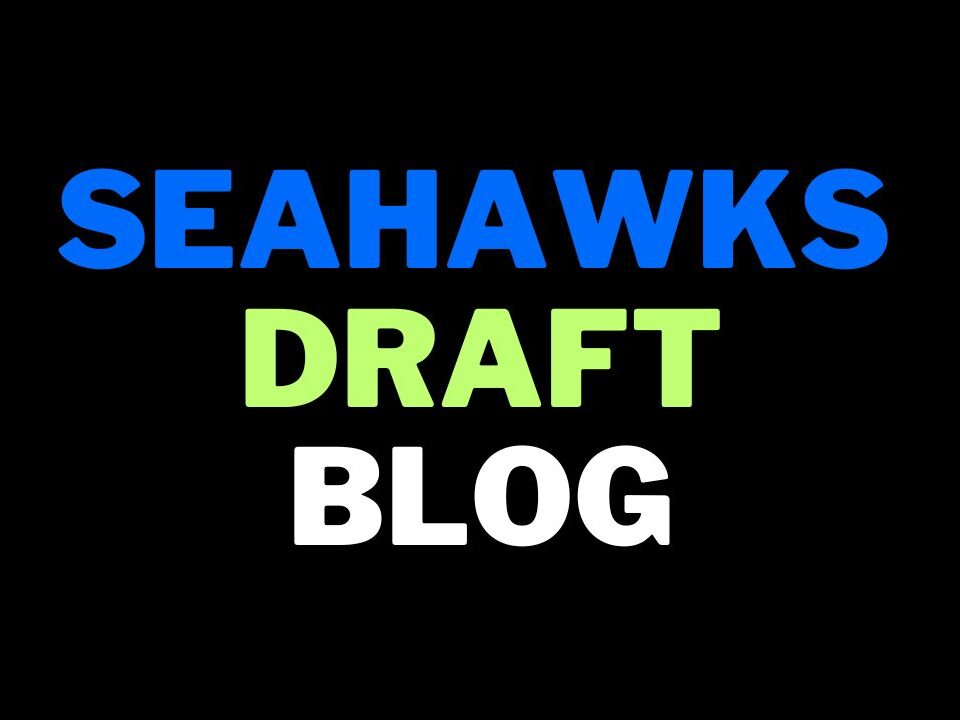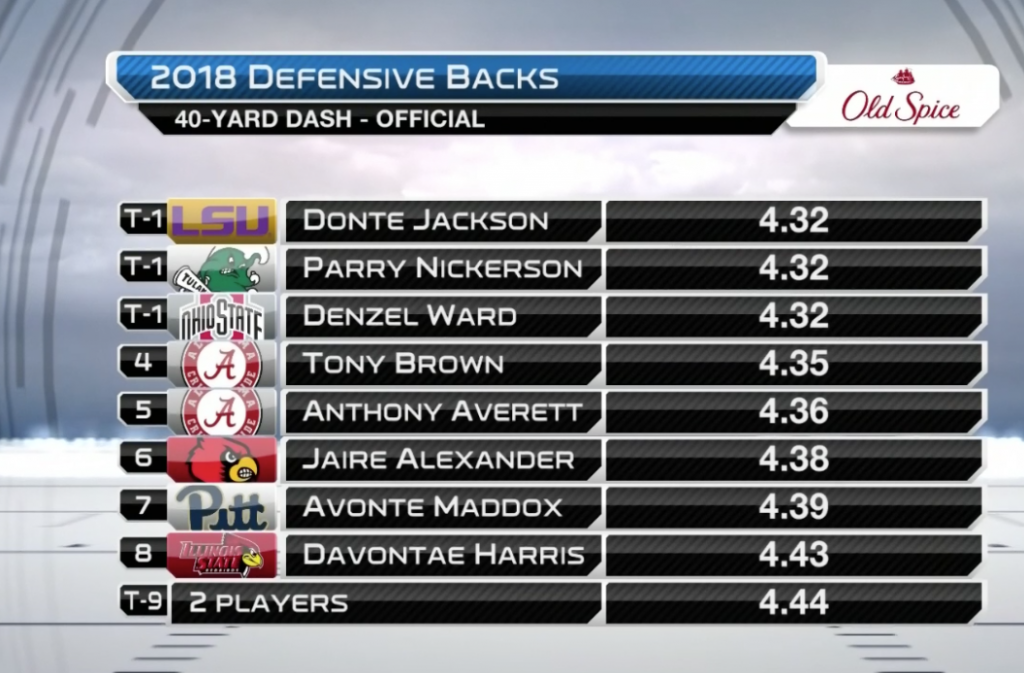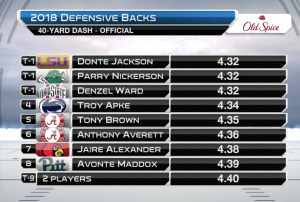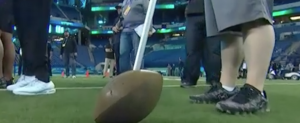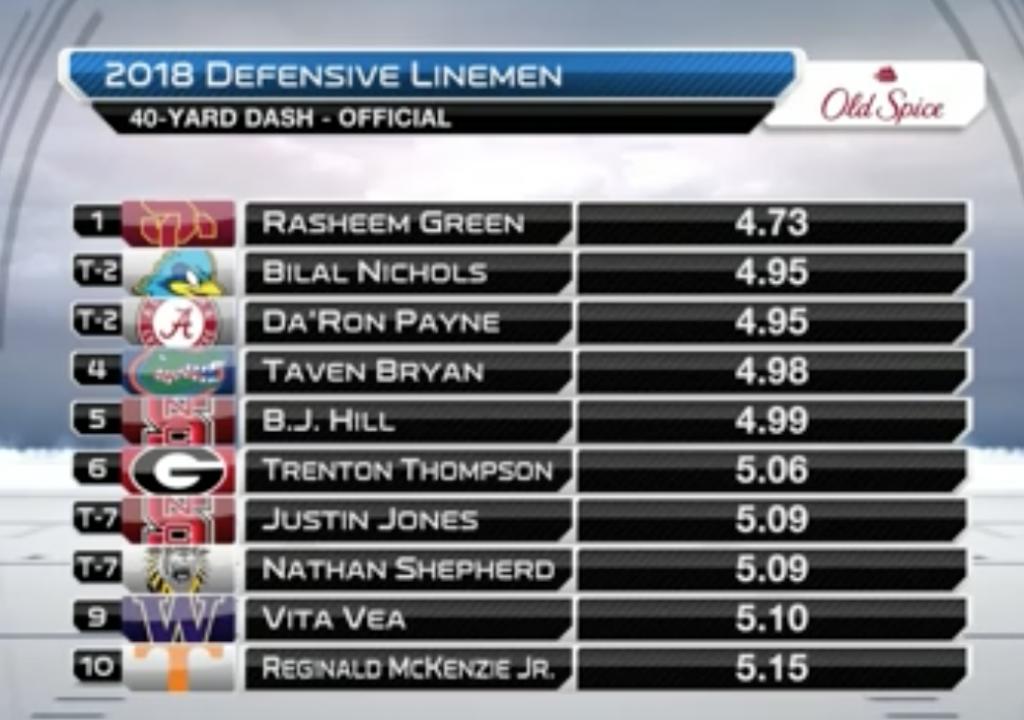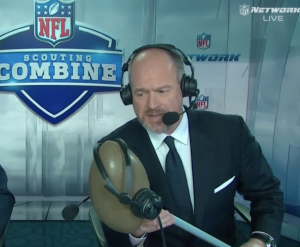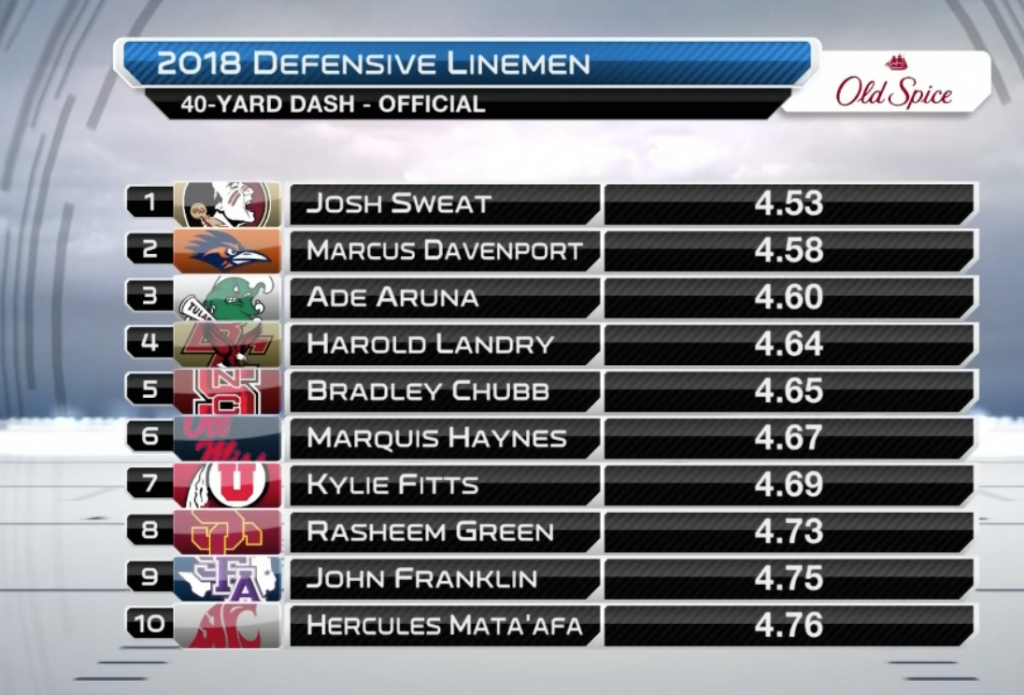Jordan Thomas has freaky agility
Since 2010, only five cornerbacks with 32 inch arms (Seattle’s prototype) have managed a sub-4.00 short shuttle:
2018 — Jordan Thomas (3.94)
2017 — Kevin King (3.89)
2016 — DeAndre Elliott (3.94)
2015 — Byron Jones (3.94), Tye Smith (3.96)
2010-2014 — No qualifiers
Thomas is the new name on a select list that includes two players Seattle eventually added (Elliott & Smith).
He also ran a 6.28 three cone. That is 0.16 seconds faster than anyone else in the last 10 years of the combine:
Jordan Thomas (2018) — 6.28
Buster Skrine (2011) — 6.44
Chykie Brown — 6.50
Grant Haley (2018) — 6.51
Avonte Maddox (2018) — 6.51
Will Davis (2013) — 6.52
Shiloh Keo (2011) — 6.55
Josh Robinson (2012) — 6.55
Kevin King (2017) — 6.56
Terrance Mitchell (2014) – 6.57
Patrick Peterson (2011) – 6.58
Curtis Brown (2011) — 6.59
Terrence Frederick (2012) — 6.59
Malcolm Jenkins (2009) — 6.59
Coty Sensabaugh (2012) — 6.60
That’s quite an achievement for Thomas. He’s not just quicker than the rest of the field, he’s considerably quicker.
On top of this, Thomas had a 38 inch vertical and a 10-4 broad jump.
The downside is he’s only 6-0 and 187lbs so he’s not the biggest but he does have 32 inch arms and a 77 6/8 inch wingspan. An average NFL cornerback has 31.5 inch arms and a 75.5 inch wingspan.
According to his NFL.com bio, Thomas is “known by scouts as an ‘over-thinker’ who has bouts of low confidence”. He’s also said to be an inconsistent tackler.
Neither aspect is particularly Seahawky. However, his athletic testing and length might interest the team late in the draft.
Running backs also excel in the short shuttle
Saquon Barkley is known for his low centre of gravity and ability to change direction quickly with explosive power and agility. He ran a 4.24 short shuttle. Nick Chubb ran a 4.25 and Kerryon Johnson a 4.29. Pretty similar times.
Without doubt Barkley is quicker and much more sudden than Chubb or Johnson but it was interesting to see how they compared in the short shuttle. They were all similarly explosive too with comparable vertical jumps.
If speed matters, is this guy an option?
Leon Jacobs, a linebacker from Wisconsin, had a quietly excellent combine. At 6-1 and 246lbs he ran a 4.48, jumped a 34.5 inch vertical and managed a 10-2 broad jump. He’s explosive and fast and also has good length (33.5 inch arms). Jacobs also put up 26 reps on the bench press (second only to Malik Jefferson among linebackers).
His short shuttle wasn’t too bad either. He ran a 4.44 — a time that compares favourably to K.J. Wright’s 4.46. If the Seahawks want speed in the front seven, Jacobs could be an option as a late-round SAM/LEO.
How quick was the safety class?
Eight players ran a 4.4 or faster at the 2018 combine. How does that compare to previous years?
2018 — 8
2017 — 5
2016 — 2
2015 — 3
2014 — 4
2013 — 3
2012 — 0
2011 — 0
At the 2011 combine the two fastest safety’s were Jeron Johnson (4.53) and Mark LeGree (4.56) — both acquired by the Seahawks.
This is the fastest group of safety’s in draft history. It’s perhaps indicative of the way college football and the NFL is going. It’ll be a surprise if the Seahawks don’t tap into the supply at some point.
Big receiver has a big day
Courtland Sutton (6-3, 218lbs) ran a faster short shuttle (4.11) than 5-10, 180lbs Keke Coutee (4.15). Coutee was quicker in the forty (4.43 vs 4.54) but in terms of agility and change of direction, that’s a nice comparison for Courtland Sutton. Essentially he’s as quick-footed as a much smaller back and he was more explosive in the vertical and broad. Sutton also managed the 11th best three-cone time by a receiver in the last 10 years.
Lauletta and Gesicki stand out
Here are the top-15 performers in the short shuttle at the 2018 combine. It’s a weird group. I’ve included position and weight in brackets:
Grant Haley (CB, 5-9, 190) — 3.94
Jordan Thomas (CB, 6-0, 187) — 3.94
Jaire Alexander (CB, 5-10, 196) — 3.98
Avonte Maddox (CB, 5-9, 184) — 4.00
Troy Akpe (S, 6-1, 200) — 4.01
Dylan Cantrell (WR, 6-2, 226) — 4.03
Josh Jackson (CB, 6-0, 196 — 4.03
J’Mon Moore (WR, 6-2, 205) — 4.04
Andre Chachere (CB, 5-11, 197) — 4.07
Chase Edmonds (RB, 5-9, 205) — 4.07
Justin Jackson (RB, 6-0, 193) — 4.07
Kyle Lauletta (QB, 6-2, 222) — 4.07
D.J. Moore (WR, 6-0, 210) — 4.07
Dorian O’Daniel (LB, 6-0, 223) — 4.07
Mike Gesicki (TE, 6-5, 247) — 4.10
Kyle Lauretta of all people is the one mixing it with nimble, smaller running backs and cornerbacks. The list also highlights Mike Gesicki’s freaky athleticism. He’s 21lbs heavier than the next biggest player on the list (Dyan Cantrell).
How important is the vertical and broad for running backs?
Here are some of the notable testers over the years:
David Johnson — 41.5 vertical, 10-7 broad
Christian McCaffrey — 37.5 vertical, 10-1 broad
Kareem Hunt — 36.5 vertical, 9-11 broad
Alvin Kamara — 39.5 vertical, 10-11 broad
Jay Ajayi — 39 vertical, 10-1 broad
Jordan Howard — 34 vertical, 10-2 broad
Melvin Gordon — 35 vertical, 10-6 broad
Jerick McKinnon — 40.5 vertical, 11-0 broad
DeMarco Murray — 34 vertical, 10-4 broad
Adrian Peterson — 38.5 vertical, 10-7 broad
Jonathan Stewart — 36.5 vertical, 10-8 broad
The historical average for a RB at the combine is:
Vertical: 35 inches
Broad: 9-11
As we can see, many of the top runners in the league exceeded the league average in both tests. There are recent exceptions though:
Ezekiel Elliott — 32.5 vertical, 9-10 broad
Leonard Fournette — 28.5 vertical, DNP
Le’Veon Bell — 31.5 vertical, 9-10 broad
Mark Ingram — 31.5 vertical, 9-10 broad
LeSean McCoy and Todd Gurley didn’t work out at the combine.
Here are some of Seattle’s notable running backs and how they tested:
Marshawn Lynch — 35.5 vertical, 10-5 broad
Chris Carson —37 vertical, 10-10 broad
C.J. Prosise — 35.5 vertical, 10-1 broad
Thomas Rawls — 35.5 vertical, 9-8 broad
Christine Michael — 43 vertical, 10-5 broad
Robert Turbin — 36 vertical, 10-2 broad
And here’s a reminder of some of the big names from the 2018 combine:
Saquon Barkley — 41 vertical, DNP
Ronald Jones II — 36.5 vertical, DNP
Nick Chubb — 38.5 vertical, 10-8 broad
Kerryon Johnson — 40 vertical, 10-6 broad
Sony Michel — DNP, DNP
Derrius Guice — 31.5 vertical, DNP
Rashaad Penny — 32.5 vertical, 10-0 broad
Royce Freeman — 34 vertical, 9-10
John Kelly — 35 vertical, 10-0 broad
Bo Scarborough — 40 vertical, 10-9 broad
How do the vertical jumps stack up?
Here are the top-15 testers this year:
Terrell Edmunds — 41.5
Mike Gesicki — 41.5
Joshua Kalu — 41.5
Matthew Thomas — 41.5
Troy Akpe — 41
Saquon Barkley — 41
Siran Neal — 40.5
Chandon Sullivan — 40.5
D.J. Chark — 40
Derwin James — 40
Kerryon Johnson — 40
Bo Scarborough — 40
Oren Burks — 39.5
D.J. Moore — 39.5
Josh Sweat — 39.5
Now here are the top three jumps from the last three years:
2017
Obi Melifonwu — 44
Speedy Noil — 43.5
Marcus Williams — 43.5
2016
Daniel Lasco — 41.5
Jalen Ramsey — 41.5
Josh Doctson — 41
DeAndre Elliott — 41
Dadi Nicolas — 41
Sterling Shephard — 41
2015
Chris Conley — 45
Byron Jones — 44.5
Ameer Abdullah — 42.5
Davis Tull — 42.5
Denzel Ward is rising for a reason
And it’s not just because this is an ugly looking cornerback class overall. Aside from running an excellent 4.32 and jumping a 39 inch vertical, Ward also managed an astonishing 11-4 broad jump.
Only five players have achieved a superior jump in the last ten years:
Byron Jones — 12-3
Obi Melifonwu — 11-9
Jamie Collins — 11-7
Chris Conley — 11-7
Bud Dupree — 11-6
Ward’s effort is identical to Julio Jones’ 11-4 and an inch longer than Jalen Ramsey’s 11-3. Clearly he’s a highly explosive and sudden athlete. He appears destined to be taken very early in round one.
Jaire Alexander also rising?
He’s started to appear in the first round of a few high profile mock drafts. It’s absolutely fair. Alexander was one of the very few cornerbacks to come out of the combine drills with any credit. He looked incredibly smooth, sudden and focused. It’s not a stretch at all to think he’s the second best corner in this class.
He also tested exceptionally well at the combine. He ran a 4.38, jumped a 35 inch vertical and a 10-7 broad. His best feat was possibly a sub-4.00 short shuttle (3.98). Alexander doesn’t fit Seattle (5-10, 196lbs, 31 inch arms) but he’ll certainly interest other teams.
You can now support Seahawks Draft Blog via Patreon by clicking the tab below.
